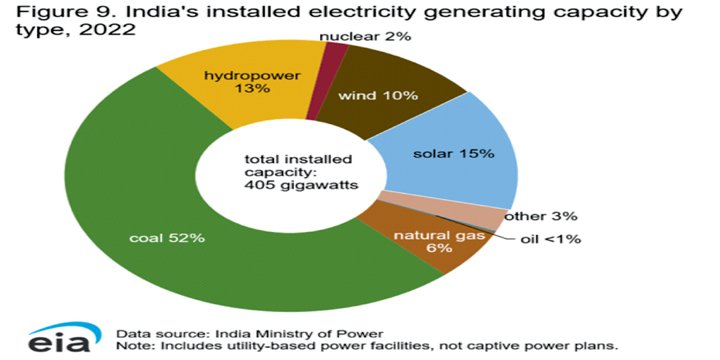Why India will continue to rely on coal for foreseeable future
Context- India said on November 30 that it would continue to rely on coal for electricity generation for the foreseeable future, even as it rapidly expanded its renewable energy sources.
This isn’t surprising, as in recent years India has steadily increased its coal production. However, it stands in stark contrast to the country’s ambitious plans of achieving net-zero — it has promised to meet 50% of its electricity requirements from renewable energy sources by 2030, and 100% by 2070.
India’s growing energy demand
- The power demand in India is surging. In 2022, the requirement grew about 8% — or at nearly double the pace of the Asia Pacific region, around more than 149.7 terawatt-hours (TWh) in comparison to the previous year, according to a recent report by Reuters. In the first two months of 2023, demand jumped 10% from a year ago
- The primary reason for this increase is higher economic activity. Industrial and commercial activity are among the biggest consumers of energy in the country. Homes account for a fourth of India’s power use and agriculture for more than a sixth in recent years, the report said.
- Moreover, India will witness the largest energy demand growth of any country or region in the world over the next 30 years, according to the latest World Energy Outlook by the International Energy Agency (IEA).
- It also added that the country’s requirement for electricity for running household air conditioners is estimated to expand nine-fold by 2050 and will exceed total power consumption in the whole of Africa today.
Coal, the only fix
- The staggering levels of power demand have become a formidable challenge for India. As a result, it has doubled down on its coal production.
- It spiked from 778 million tons in 2021-22 to 893 million tons in 2022-23, a 14% growth, according to the coal ministry. India has also set a target of 1.31 billion tonnes of coal production for 2024-25 and aims to increase it to 1.5 billion tons by 2030.
- But why is coal so essential to India’s plan to meet the growing power demand? There are four reasons for this.
- First, although India has been trying to push up its renewable share of power generation in recent years, it’s nowhere near meeting the requirement.
- Currently, out of the total energy produced in the country, only 22% of it comes from renewable sources, according to a recent report by Wood Mackenzie. Fossil fuels, mainly coal, still provide 75% of India’s power supply
- Second, renewables aren’t a reliable source of power generation. Energy sources like solar and wind are variable as they rely on natural factors like sunlight, wind and water availability.
- To ensure a steady supply, India has to heavily invest in battery storage — it “needs more than 60 GW of battery storage to fully utilise the potential of its 2030 renewables goal,” a report by Context News said. However, grid-scale battery storage is expensive due to supply chain disruptions.
- Third, hydropower, a key renewable energy source for India, has its own complexities. Numerous hydropower projects are under construction or in the planning stages in the Himalayan region, including in Arunachal Pradesh and Sikkim.
- But they have come under fire as the projects have caused ecological damage and raised concerns about the potential conflicts over water resources in the area.
- Fourth, the country’s plans to generate energy with the help of nuclear power plants have not really taken off. During 2021-22, the plants produced about 3.15% of the total electricity generated in India, said Union Minister Jitendra Singh in a reply to the Lok Sabha last month.
What’s next
- India aims to reach 500 GW of renewable energy capacity by 2030, about three times the current capacity of about 180 GW. However, given the constraints regarding renewable energy, it will continue to fall back on coal-generated electricity.
Way Forward- “As per the targets set for 2030, the fossil fuel capacity (in electricity generation) would come down from the current about 60% to about 35%. This is the phase-down. If we are talking in absolute terms, the numbers (installed capacity of coal) will go up because our demand (for electricity) is going up (between now and 2030). In percentage terms (as a share of overall production), it will come down” Union Minister of Power and New and Renewable Energy, R K Singh.
Syllabus- GS-3; Energy
Source- Indian Express


